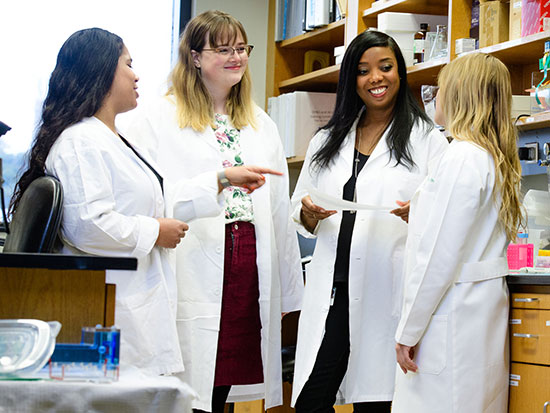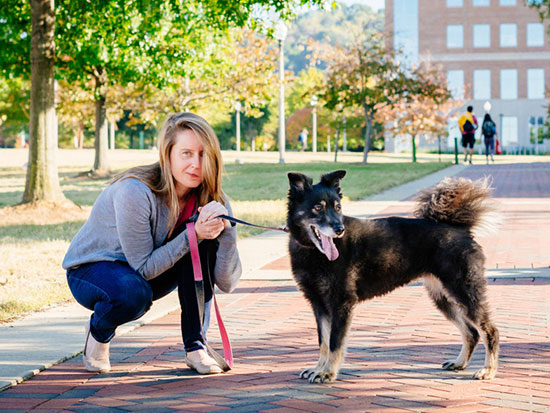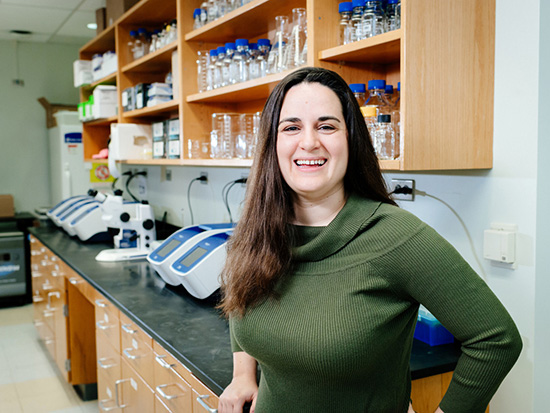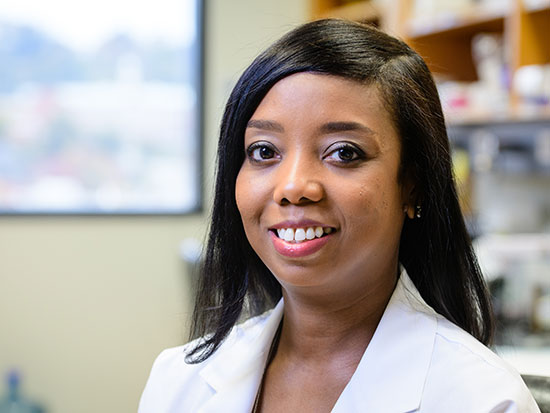 Farah Lubin (second from right) with graduate students and lab members Silvienne Sint Jago, Rebecca Hauser and Megan Rich-Hu.Expectations will overwhelm you if you let them.
Farah Lubin (second from right) with graduate students and lab members Silvienne Sint Jago, Rebecca Hauser and Megan Rich-Hu.Expectations will overwhelm you if you let them.
When she was in high school, Farah Lubin, Ph.D., worked as a nursing assistant and planned to go into medicine. But “my parents did not take me seriously when I told them I was going to college,” said Lubin, an associate professor in the Department of Neurobiology. “They thought their sons would go to college, but they expected the girl to stay home until she got married.”
Lubin was mad — so upset, in fact, that her father arranged for her to join a group of other New York City students on a tour of Historically Black Colleges and Universities. “That’s when I learned I was black,” Lubin said. “New York is a very diverse city. But I learned about African American history on that trip and that somehow my ethnicity or race was supposed to be a limitation. That I was not supposed to be a success story.”
‘Not supposed to be a success’
Lubin has been a success story since she arrived at UAB in 2005 as a postdoc in the lab of David Sweatt, Ph.D. Lubin and many others made the move with him from Baylor College of Medicine, when Sweatt was recruited to be chair of neurobiology.
Lubin was one of the first UAB scientists to land one of the NIH’s elite K99/R00 Pathway to Independence grants in 2009. A few years later, she was the first K99 funded by the National Institute of Mental Health to transition to the R00 (independent faculty) portion of the grant. Her research has helped prove that epigenetic mechanisms operate in the brain, a once-heretical idea that has since opened new advances in the study of memory. That work is funded by a R01 Research Project Grant Award, the flagship grant of the NIH, along with an R21 Developmental Research Grant Award. Lubin also is the co-director of UAB’s Neuroscience Roadmap Scholars Program, funded by a $1.25 million R25 grant.
“One of the reasons I was motivated to do Roadmap is I was tired of being ‘the only’ — the only woman, the only minority, the only minority woman — everywhere I went,” Lubin said. She once was invited to give the keynote address at a scientific meeting. “Usually when you’re giving one of those talks you send your abstract and the title and that’s it,” Lubin said. “I never think about filling out my demographic information. But a little while later I got an angry email from the organizers, accusing me of not telling them I was a black female.
| “One of the reasons I was motivated to do Roadmap is I was tired of being ‘the only’ — the only woman, the only minority, the only minority woman — everywhere I went.” |
"In a way I understand, because programs have NIH funds available if they bring in diversity representation and they want to document that, but why is that my responsibility?” The problem, Lubin said, is that “a lot of people are not good at explaining diversity. That happens to a lot of under-represented students. When they are interviewing they are told, ‘You are here because you’re a minority.’ And they’ll think, ‘Oh, I thought I was here because I was smart.’
“If you’re constantly being told that it’s a shock that you’re here, you start thinking that about yourself,” Lubin continued. “There is a sharp dropoff among minority students and students from disadvantaged backgrounds who are excited about science at the graduate student stage. Lori McMahon [Roadmap co-director and dean of the UAB Graduate School] and I value the mentorship of students. We came up with a program that we would want to see in place if we were students.”
Pathway to the brain
Lubin’s own career roadmap started with her HBCU road trip. She received full scholarship offers from several schools, choosing Alabama State University because of the Minority Biomedical Research Support Program, an NIH-sponsored initiative that offered paid research internships each summer. “During that experience I realized that being at the bench excited me more — the chance to find cures,” Lubin said. “I was a nursing assistant during the HIV/AIDS epidemic, when we didn’t really understand how you got from HIV to AIDS. A lot of my patients died. I realized that research is where you understand how things work and get to the cure.”
Commitment to success for allFarah Lubin’s dedication to mentoring and her work with the Roadmap Scholars Program are perfect examples of the UAB shared values of diversity and inclusiveness, which call for all members of the university community to actively seek varied perspectives. |
Lubin went back to New York to earn her doctorate in molecular biology, focused on immunology, at Binghamton University. But by the time she graduated, all the best postdoc positions were in neuroscience, she said. She went to Baylor College of Medicine in Houston, Texas, working on epilepsy in the lab of Anne Anderson, Ph.D., before joining Sweatt’s lab. At the time, Sweatt was interested in the epigenome, the array of chemical markers on and around the genome that help regulate which genes are switched on and off, and control the rate of production, “but no one was doing epigenetics in the nervous system,” Lubin said. “I knew that people were studying T and B memory cells, so I took a chance and wrote a proposal to study epigenetic mechanisms of memory and a proposal on memory disorders in epilepsy.”
Epilepsy has been a fascinating source of discoveries about memory, Lubin explained. “Patients sometimes have to have surgery to remove parts of the brain where seizures originate.” By studying what happens afterward to those patients’ memories, “we learn what these brain regions are responsible for.”
Brakes be gone
Although Lubin continues to work in epilepsy (she is now involved in a study with UAB’s Jane Allendorfer, Ph.D., an assistant professor in the Department of Neurology, investigating the effects of exercise in the disease), her research has expanded to focus on larger issues of memory formation, including one of the biggest of all: Why do our memories falter with age?
| “I learned along the way, ‘I can do this. I’ve got this.’ And it was because I forced myself to be in fearful situations until I got used to it.” |
In July, her lab published a paper in the journal Science Signaling that attracted widespread media coverage. Using advanced tools such as CRISPR gene editing and single-cell RNA sequencing, Lubin demonstrated that an epigenetic factor, a tissue-specific, long noncoding RNA known as NEAT1, has a major role in memory formation. High levels of NEAT1 in the hippocampus, the small structure in the center of the brain that is highly involved in memory formation, act as a brake on the memory-formation process by disrupting production of memory-associated genes like c-FOS, her team found.
When NEAT1 “is on, we aren’t learning, at least not as much as we might with it off,” Lubin told UAB News. “In a younger brain, when presented with a stimulus that promotes learning, NEAT1 turns off.” In aging brains, NEAT1 levels are high, however, and older mice perform poorly on memory tasks compared with younger mice. But when Lubin interfered with NEAT1 production in the brains of older mice, they demonstrated normal abilities in learning and memory. And when she increased NEAT1 production in the younger mice, their ability to learn and remember declined. “This gives us very strong evidence that NEAT1 and its effects on the epigenetic control of c-FOS are one of the keys to memory formation,” Lubin said.
Sticking with it
“I love the joy of new discovery,” Lubin said. “I get excited when I look at a textbook and one of my papers is cited at the end of a chapter. That’s when I know I’ve changed the face of science.”
But Lubin also is energized by keeping new faces in science. “I love mentoring,” she said. “It’s so rewarding to see students succeed.” Part of it is sharing her own experience. “I didn’t think I would be a professor; I thought I would be a staff scientist,” she said. “But I learned along the way, ‘I can do this. I’ve got this.’ And it was because I forced myself to be in fearful situations until I got used to it.”
One of the strengths of the Roadmap program is that it builds community, Lubin said. “We provide a safe space for these students to talk about their insecurities or their anger at always feeling like all eyes are on them. It gives them a sense of security to recognize that others are experiencing the same thing.”
Overcoming inadequacy
The Roadmap Career Coaches also help students answer questions about their relationships with their mentors. “They don’t want to feel that they are asking for help all the time, because they already feel insecure in certain ways — a perception that they are inadequate,” Lubin said. “What’s the best way to approach my PI about this? Am I misunderstanding, overreacting? Am I being personally targeted or is this normal?”
The reality for now, Lubin tells under-represented students, is that “they will be the novelty in the room, that they will be pointed out,” she said. “If no one is used to you being around, they will ask you questions. Don’t get angry about it, just accept it.”
The career coaches have another role. “They are cheerleaders,” Lubin said. “If you need a letter of recommendation, or just some encouragement and direction, they are there. People usually don’t want to brag on themselves; they’ll brag about you.”
Becoming CEO
Science is a process of discovery about yourself as well as about the world, Lubin explains. Running your own lab, as Lubin does, has been described as being the CEO of a small business. “The administrative stuff — the business side of writing grants, paying people, that’s what scares students,” Lubin said. “Starting my own lab was super-scary. I was suddenly responsible for people’s training, salaries.” She enjoys these aspects now, Lubin said, but it took time. “Everyone who runs a small business knows the satisfaction you feel that you are doing something productive. Plus, there’s the joy of intellectual freedom. I own my ideas, and I can see something through from start to end.”
Lubin loves mentoring, primarily because “I genuinely enjoy seeing people make it,” she said. Mostly, she said, the role is primarily to be an encourager as students walk through the scary steps toward independence. “Everyone has to find their unique niche,” Lubin said. “How can you separate yourself from your mentor in terms of what you’re working on?”
The fear of failure is a powerful thing. “When I started my lab, I thought, ‘These students are taking a chance with me. What if I give them the wrong ideas and they fail?’ But eventually I said, ‘I’m just going to do it and forgive myself if I fail, so I can at least say I tried.’ That was a huge relief, just changing my mindset. That’s why I always give my students permission to fail. That’s all they need. They are still apprehensive — I still get scared, too — but you’ll never know if your ideas work unless you test them. Ask any professor and they will say they really enjoy what they do. They’ll talk forever about it if you give them the chance. I tell mentors, ‘Share more often why you get excited about your science.’ It’s a thrill.”
Read about two more K99/R00 innovators at UAB:

Young investigator’s ‘kangaroo’ vaults her aging research onto a new level


 Farah Lubin’s advice for young scientists:
Farah Lubin’s advice for young scientists: